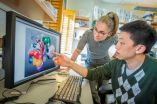(Press-News.org) What is the cost of rare diseases such as Friedreich's Ataxia? By analyzing direct and indirect costs of care research in BioMed Central's open access journal Orphanet Journal of Rare Diseases calculated that conservatively this rare disease costs between £11,000 and £19,000 per person per year. Proper understanding resource allocation is important in minimizing the effect of Friedreich's Ataxia on people's lives while maximizing their quality of life.
Diseases are classified as 'rare' if they affect less than 1 in 2000 people. Lack of scientific knowledge means that these diseases can be difficult to diagnose and treatment options are limited. Rare Disease Day, February 28th, aims to raise awareness of rare diseases and their impact on people's lives.
Friedreich's Ataxia, caused by mutations in the gene encoding the protein frataxin, results in progressive damage to the nervous system. Although rare, it affects one in 50,000 people, and consequently is the most frequent of the inherited ataxias, which all affect a person's ability to control their muscles. Symptoms usually begin in childhood, and affected people need continual monitoring to assess and assist with developing problems.
Dr Paola Giunti from the UCL Institute of Neurology and UCLH, explained, "The costs of more common progressive diseases such as Parkinson's Disease are known but it is not really possible to base budget allocations of one disease on the expectations of another without understanding the differences in need."
People with Friedreich’s Ataxia need specialists, nurses and carers, and there are direct and indirect medical costs, home modifications and loss of earnings to be considered. On the 75 people in the study alone, the UK spent £240,000 on medical care and £300,000 on educational support, respite care, and other support in one year.
But the costs are not just medical. Loss of employment due to Friedreich's Ataxia is estimated at over half a million pounds each year. There are also hidden costs as many people with Friedreich's Ataxia are children and young adults who are predominantly cared for at home by their families.
Dr Paola Giunti continued, "Our results show that the needs of people with Friedreich's Ataxia are different, with different costs, to people with Parkinson's Disease and that a 'one size fits all' strategy is unlikely to provide the best care to people with rare diseases."
### Media contact
Dr Hilary Glover
Scientific Press Officer, BioMed Central
Tel: +44 (0) 20 3192 2370
Mob: +44 (0) 778 698 1967
Email: hilary.glover@biomedcentral.com
Notes
1. Impact of Friedreich's Ataxia on health-care resource utilization in the United Kingdom and Germany
Paola Giunti, Julia Greenfield, Alison J Stevenson, Michael H Parkinson, Jodie L Hartmann, Ruediger Sandtmann, James Piercy, Jamie O'Hara, Leo Ruiz Casas and Fiona M Smith
Orphanet Journal of Rare Diseases (in press)
Please name the journal in any story you write. If you are writing for the web, please link to the article. All articles are available free of charge, according to BioMed Central's open access policy.
Article citation and URL available on request on the day of publication.
2. Orphanet Journal of Rare Diseases is an open access, online journal that encompasses all aspects of rare diseases and orphan drugs. The journal publishes high quality reviews on specific rare diseases. In addition, the journal may consider articles on clinical trial outcome reports, either positive or negative, and articles on public health issues in the field of rare diseases and orphan drugs.
3. BioMed Central (http://www.biomedcentral.com/) is an STM (Science, Technology and Medicine) publisher which has pioneered the open access publishing model. All peer-reviewed research articles published by BioMed Central are made immediately and freely accessible online, and are licensed to allow redistribution and reuse. BioMed Central is part of Springer Science+Business Media, a leading global publisher in the STM sector. @BioMedCentral
4. In recognition of the need to raise awareness of rare diseases, in 2008 a cluster of European countries instigated Rare Disease Day on what is itself a "rare day" – the 29th February. Five years on, Rare Disease Day is an international event marked across the globe, a feat which is testament to the strong desire of patients and their families to raise awareness of these little known and little understood conditions.
This year Rare Disease Day will be marked on the 28th February, the theme is 'Rare Disorders without Borders.' The theme highlights the face that advances in rare disease research have more chances of succeeding if sought after internationally when hundreds of teams of researchers from different countries work together to understand the disease and find therapies. This not only makes financial sense but can help spread good practice so that those affected by rare diseases can benefit.
Starch-based intravenous (IV) fluids used by the NHS to treat seriously ill patients are causing unnecessary deaths, according to a new Cochrane systematic review by researchers at the London School of Hygiene & Tropical Medicine.
Based on data from 25 randomised control trials, the researchers concluded that starch-based colloid fluids, used to stabilise patients with low blood pressure, are not only more expensive than saline-based crystalloid fluids, but may also be causing around 250 unnecessary deaths in the UK every year.
The study included 9,147 seriously ill ...
Imagine a sphere more than 2 million miles across - eight times the distance from Earth to the Moon - spinning so fast that its surface is traveling at nearly the speed of light. Such an object exists: the supermassive black hole at the center of the spiral galaxy NGC 1365.
Astronomers measured its jaw-dropping spin rate using new data from the Nuclear Spectroscopic Telescope Array, or NuSTAR, and the European Space Agency's XMM-Newton X-ray satellites.
"This is the first time anyone has accurately measured the spin of a supermassive black hole," said lead author Guido ...
DURHAM, N.C. -- In experiments mimicking a natural environment, Duke University researchers have demonstrated that the silver nanoparticles used in many consumer products can have an adverse effect on plants and microorganisms.
Fifty days after scientists applied a single low dose of silver nanoparticles, the experimental environments produced about a third less biomass in some plants and microbes.
These preliminary findings are important, the researchers said, because little is known about the environmental effects of silver nanoparticles, which are found in textiles, ...
Research indicates that half of all lifetime cases of mental illness begin by age 14, well before adulthood. Three new studies investigate the cognitive, genetic and environmental factors that may contribute to mental health disorders in adolescence. The studies are published in Psychological Science and Clinical Psychological Science, journals of the Association for Psychological Science.
Social-Information-Processing Patterns Mediate the Impact of Preventive Intervention on Adolescent Antisocial Behavior
Kenneth A. Dodge, Jennifer Godwin, and The Conduct Problems ...
An international team including Lawrence Livermore National Laboratory scientists has definitively measured the spin rate of a supermassive black hole for the first time.
The findings, made by the two X-ray space observatories, NASA's Nuclear Spectroscopic Telescope Array (NuSTAR) and the European Space Agency's XMM-Newton, solve a long-standing debate about similar measurements in other black holes and will lead to a better understanding of how black holes and galaxies evolve.
"We can trace matter as it swirls into a black hole using X-rays emitted from regions very ...
Children who failed to acquire a basic math skill in first grade scored far behind their peers by seventh grade on a test of the mathematical abilities needed to function in adult life, according to researchers supported by the National Institutes of Health.
The basic math skill, number system knowledge, is the ability to relate a quantity to the numerical symbol that represents it, and to manipulate quantities and make calculations. This skill is the basis for all other mathematics abilities, including those necessary for functioning as an adult member of society, a ...
Researchers have successfully piloted a process that enables natural resource managers to take action to conserve particular wildlife, plants and ecosystems as climate changes.
The Adaptation for Conservation Targets (ACT) framework is a practical approach to assessing how future changes in air and water temperatures, precipitation, stream flows, snowpack, and other environmental conditions might affect natural resources. ACT enables scientists and managers to work hand-in-hand to consider how management actions may need to be adjusted to address those impacts.
"As ...
(Santa Barbara, Calif. –) Bioengineering researchers at University of California, Santa Barbara have found that changing the shape of chemotherapy drug nanoparticles from spherical to rod-shaped made them up to 10,000 times more effective at specifically targeting and delivering anti-cancer drugs to breast cancer cells.
Their findings could have a game-changing impact on the effectiveness of anti-cancer therapies and reducing the side effects of chemotherapy, according to the researchers. Results of their study were published recently in Proceedings of the National Academy ...
COLUMBIA, Mo. — Fashion retailers have seen an increase in demand for maternity wear in recent years, as sales for maternity clothing have increased while overall women's apparel sales have declined. Currently, most retailers produce maternity wear using a standardized size chart that begins with women in their seventh month of pregnancy. Retailers produce garments for women who are earlier in their terms by adjusting the sizes smaller proportionally based on the standardized chart. In a recent study, University of Missouri researcher MyungHee Sohn, an assistant professor ...
Researchers with the U.S. Department of Energy (DOE)'s Lawrence Berkeley National Laboratory (Berkeley Lab) have achieved a major advance in understanding how genetic information is transcribed from DNA to RNA by providing the first step-by-step look at the biomolecular machinery that reads the human genome.
"We've provided a series of snapshots that shows how the genome is read one gene at a time," says biophysicist Eva Nogales who led this research. "For the genetic code to be transcribed into messenger RNA, the DNA double helix has to be opened and the strand of gene ...




